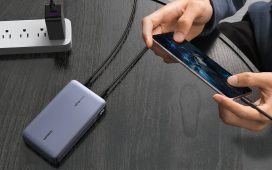Verdict
Bluetti’s AC50B is a great portable power station. While it’s not bristling with ports, it covers all the basics, and can both store and supply plenty of electricity for everyday use. This isn’t a brute capable of getting you through laundry day, but if you want a compact supply for camping, or to keep your home office going in a power cut, the AC50B offers reliability and strong value.
Pros
- Compact and portable
- Good usability
- Great value
Cons
- Not the most efficient power supply
-
A light-medium duty battery power stationThe AC50B is designed for portable use, or for light-medium backup duties around the home. It’s got decent specifications and a fair range of ports, but don’t expect it to power kitchen or laundry appliances. -
App controlConnect via Bluetooth and use Bluetti’s app to monitor energy usage, or change things like the charging speed.
Introduction
Not everyone needs a big and powerful battery power station. Bluetti’s AC50B is aimed at fairly light backup power applications, and for smallish groups who need off-grid power on a camping trip. Despite having enough poke to keep the lights, computers and phones on, it’s quite compact and luggable. It’s easy to use, too.
This power station can store up to 448 watt hours (Wh) of electricity, just under half a kilowatt hour. That gives you enough energy to fully charge a typical smartphone around 10 times, or run a low-energy bulb for a couple of days.
The AC50B can provide a reasonable 700 watts (W) of mains power at a time, which covers almost any household device save kitchen or laundry appliances. It’s filled with lithium iron phosphate (LFP) batteries, which Bluetti says will still offer at least 80% of their initial capacity after 3000 charge cycles. It backs that up with a strong five-year warranty.
Like most other Bluetti power stations, you can use a smartphone app to monitor the AC50B, or tweak things like its charging speed. Despite weighing nearly seven kilos, its fat moulded handle makes this an easy power station to lug around.
Design and Features
- Neat and portable
- A fair selection of ports
- Helpful display and labelling
Typically for power stations storing around half a kilowatt hour (kWh), the Bluetti AC50B is about the size of a toaster.
It feels rugged and chunky, with a comparatively fat and smooth handle that’s comfortable to keep hold of for a while. I wouldn’t want to take any battery power station for a hike, but it’s easy to lug this one about a campsite, and it might even fit in bigger bike panniers.
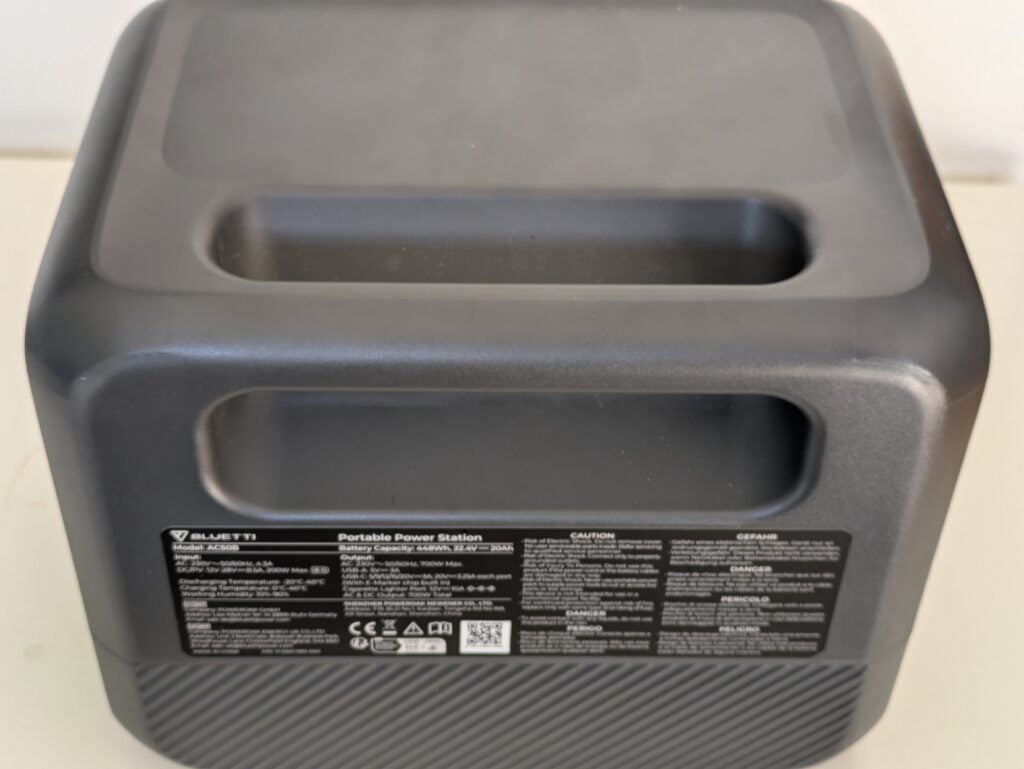

If you are looking for a mobile power station, I should flag up some potential limitations here. The AC50B has only a single AC power socket, so you’ll need to pack an adaptor if you have more mains devices.
There are three USB ports, which might get frustrating if you’re camping as a group of four or more. Campers might also rue the lack of a built-in light – if you are after a mobile supply with more sockets, power and lights, consider spending more on the Anker SOLIX C800 Plus.
Otherwise, it’s hard to grumble about any of this power station’s features. All ports bar the AC input are on the front panel, clearly labelled to show their maximum output. There’s a compact screen to show the current battery charge, the power going in and out, and how long it’ll take before the battery is flat or fully charged – depending on the balance.
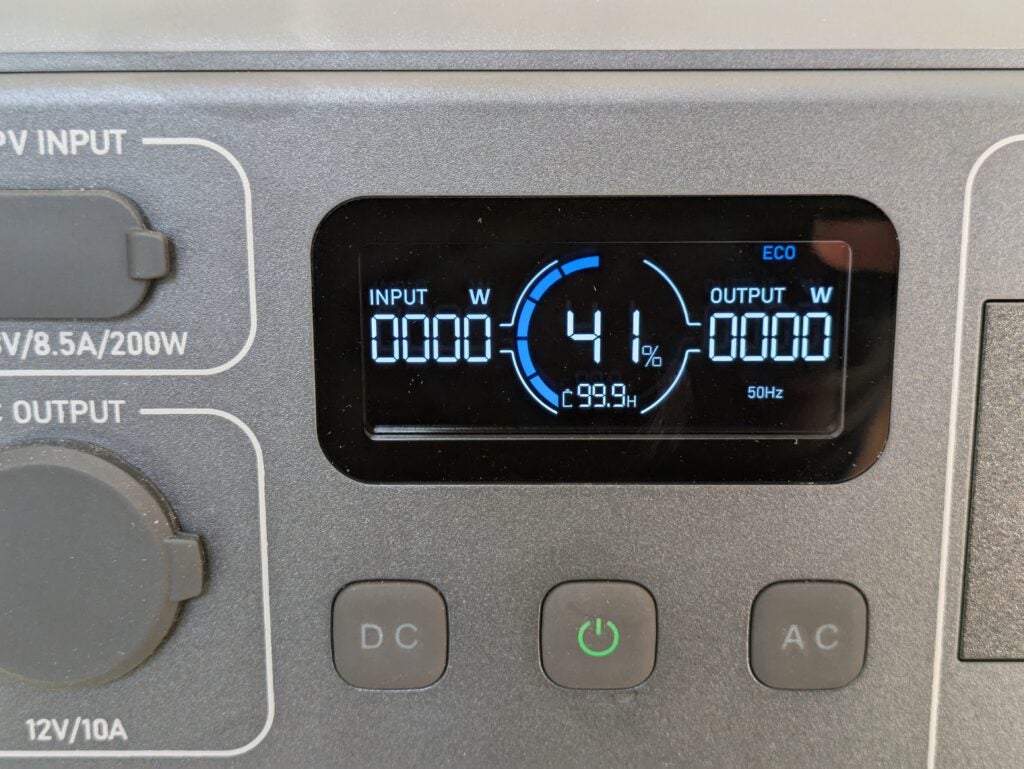

The USB ports comprise a single type-A rated at 15W, and two USB-C slots capable of 65W each – enough to fast charge modern smartphones. Additionally, there’s a 120W car charging port. Just above you’ll find an XT60 DC input socket, allowing you to charge from a car or solar panels using the supplied cables.
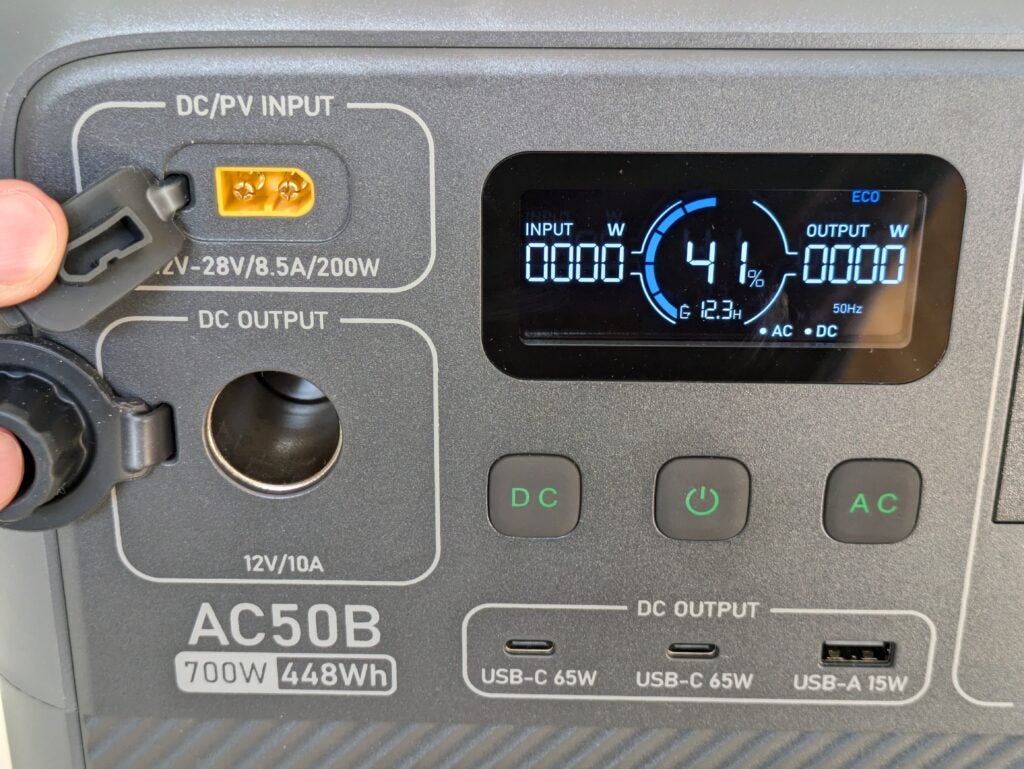

This power station works with Bluetti’s app, although it supports only Bluetooth connections, not Wi-Fi like some other models. You can use it to see more detail of AC and DC power flow through the device, but also to configure more advanced settings such as the charging mode and auto shutoff parameters.
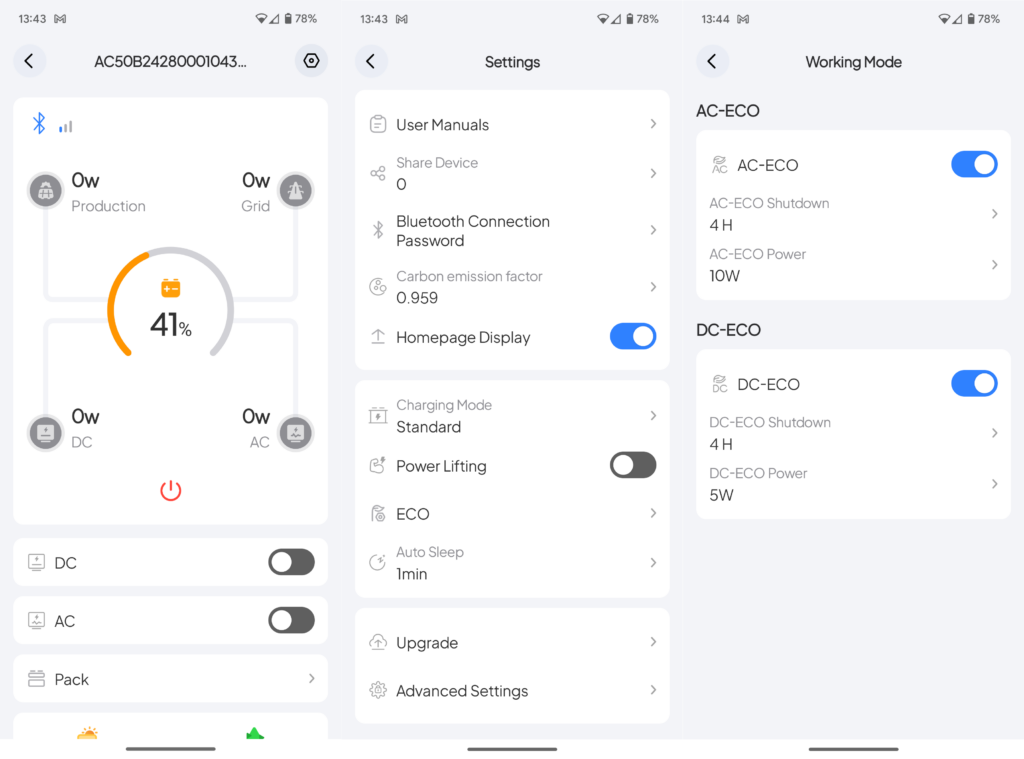

While the Bluetti AC50B isn’t marketed as a home backup device, it could be suitable. Its 700W output should be enough to run at least a couple of desktop workstations, along with a couple of desk lights and an inkjet – but not a laser printer, which has a much higher peak consumption.
I’d expect it to power a modest single-user setup for at least a couple of hours from a full battery, although there’s no audible warning to let you know when the power is about to run out.
Bluetti says that in a power cut, this power station can switch from mains bypass to battery mode in less than 20 milliseconds. That’s not as fast as a dedicated UPS, but it should be quick enough to avoid upsetting most PCs or digital equipment. I connected it to my workstation and NAS, and turned the input power on and off a few times with no ill effects.
Charging
- Charge from mains, car, or the sun
- Maximum 580W total charging power
- Full recharge in just over an hour
Bluetti supplies the AC50B with the usual car charging cable, however its DC input port is limited to 8.5A, which equates to 102W at the 12V typical of most cars. At that rate, the battery would be fully charged after about five hours of driving, which might be practical on longer trips.
This power supply can also accept up to 200W of solar power, but there are a couple of important things to note. The first is that Bluetti supplies a lead with MC4 connectors, which are more typical of permanent solar panels – you may need an MC4 to XT60 convertor to use portable arrays. The second is that you’re limited to a maximum open circuit voltage of 28W, which rules out some 200W panels altogether – it’s important to check before you buy.
Like many Bluetti power stations, the AC50B has three mains charging modes: Silent, Standard and Turbo. Here, they equate to around 170W, 275W and 580W, respectively, letting you prioritise speed when you need it, or opt for comparative calm when you don’t. Choosing the lowest setting will help maximise the batteries’ working life and could help where there’s limited power available for charging – such as on a campsite hookup. There’s some fan noise, whatever mode you choose, but it’s never harsh.


I tested all three modes, using a mains meter to measure how much power it took to restore an empty battery to fully charged. Standard mode was the most efficient, with just 525Wh consumed for charging, which took just under two hours. In Turbo mode, charging consumed 532Wh and completed in a speedy 65 minutes. Silent mode took about three hours, consuming 536Wh.
It’s possible to combine DC and AC charging, but it won’t top up the AC50B significantly quicker. In Standard and Turbo modes, PV input is prioritised, with mains power used to top the charge up to the same limits given above. In Silent mode, you get a slightly higher 195W maximum total input.
Performance
- Stable power output with quiet fans
- Useful Power Lifting mode
I test every power station at its maximum specified output, but I ran into a problem with the Bluetti AC50B: I couldn’t find a combination of devices that added up to the right amount. The nearest I could get, about 760W, was substantially above the stated 700W maximum: the supply sustained it for about a minute before shutting itself down. It was unruffled with any other load I tested up to around 630W, and from experience with other Bluetti devices I’d expect it to be fine at 700W or even slightly above.
The AC50B can handle quite a high power peak for such a compact device, with its 700W output enough for almost anything except kettles and other heaters, or most laundry devices. It was enough to run my modern condenser tumble dryer, although with a modest 448Wh of stored charge, it was out of power before the load was dry.
If you need a bit more power, you could use the app to enable Bluetti’s power lifting mode, which supports devices rated at up to 1000 watts (1kW). This works by limiting the voltage and current of the mains port, which in turn stops any connected device drawing more than the rated 700W – in other words, it doesn’t actually supply more power, but it can limit more heavy duty devices so they don’t demand more than the port can supply.
It works well in practice, but only with simple, resistive loads such as a travel kettle or iron – digital devices like televisions might be upset by the non-standard power supply.
Measuring the power output, I found that the Blueetti AC50B was quite efficient. Running with a 200W load, I found it delivered 402Wh (89.73%), and with a 500W load it delivered 395Wh (88.17%). Its best effort was 410Wh supplied via USB-C, equating to an impressive 91.5% of its stated battery capacity.
I give a rough guide to a power station’s value by dividing its cost by the amount of energy it might store over its lifetime. Even at its standard price of around £400, the AC50B works out at 33p per kWh of stored energy – that’s excellent for this class of device. At its discounted price, this drops to 25p per kWh, which is the lowest I’ve yet seen.
Latest deals
Should you buy it?
You want a portable power brick with a bit of poke
This is a reasonably pokey power supply given its size, which is a bonus given that it’s comparatively portable and easy to use.
You’re looking for bonus features
The AC50B isn’t badly specified, but if you want lights and lots of ports you might want to pay more for the Bluetti AC240.
Final Thoughts
This is a compact and very portable power supply that’s well matched to smallish groups of campers, provided they don’t want built in lights.
It’s quite well specified for home users, too, offering a couple of hours’ backup for one or two workstations in a home office. I like its usability, especially the fact that every port’s capabilities are clearly written right next to it.
This power station isn’t especially efficient, but I’m particularly impressed by its value – at the time of my review I saw it discounted to £299, which amounts to one of the lowest costs per unit of stored energy I’ve yet seen. Bluetti’s pricing here amounts to great value, but it’s also a clear reflection of falling battery prices, and increasing competition as more manufacturers enter the home energy storage market.
How we test
We test every battery station we review thoroughly over an extended period of time. We use standard tests to compare features properly. We’ll always tell you what we find. We never, ever, accept money to review a product.
Find out more about how we test in our ethics policy.
We test with a variety of devices to see how long the battery will last.
We test different charging methods to see how quickly the battery can be topped up.
FAQs
Most Bluetti battery power stations use lithium iron phosphate batteries, which will typically provide 3,000 full charge cycles before they’re down to 80% of their initial capacity. That’s more than eight years if you fully charge and discharge them each day. Bluetti backs up its devices with a five-year warranty, too.
The short answer is yes. Almost every Bluetti power station can run a USB or car-adaptor fridge, while many of them also have the power to run a full-sized kitchen fridge or fridge freezer. To be sure, check the maximum rated power of your fridge against the maximum output power of the battery power station you’re thinking of buying. Consider also how long you want to run the fridge for – a modern fridge freezer typically uses between 0.5 and 1 kilowatt hour (kWh) of power each day, so if you want a full day’s running, you might need a power station that stores at least 1kWh.



